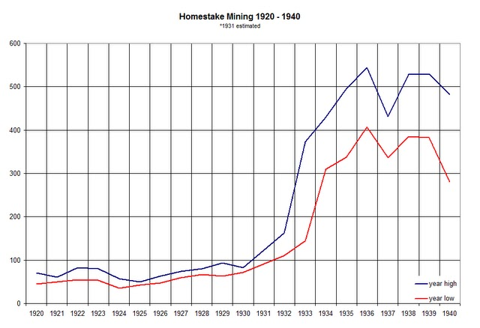In my last posting, a somewhat loquacious article, I
described a small piece of native silver collected from the famous Homestake
Mine in Lead, South Dakota. Crystalline
silver of any sort is rather rare in rocks of the Black Hills, including the Homestake. My specimen was collected many decades ago
and originally was in the collection of Carroll “Shorty” Withers but later was
obtained by Willard Wulff; both gentlemen are famous Colorado micromounters. Since then I have looked for specimens of Homestake
gold; however, two items have held up my search: 1) most of the gold mined from
the Homestake, especially in recent decades, was intimately tied up with the
parent rock; and 2) the few specimens of “free gold” that I have seen are
really, really expensive and often are marked “not for sale.”
So, where was an ole guy like me to find Homestake
gold? Well, believe it or not I was able
to purchase several small flakes at the Sanford Museum overlooking the big open
pit. According to a Certificate of Authenticity, when the South Mill at Homestake
was being decommissioned in 2002, flakes of gold (67 total ounces) were
discovered in the bottom of a concrete ditch that was previously used to
transfer the ore slurry within the mill.
The surface of these flakes resemble nuggets; however, they were
flattened in the stamp mills before taking a ride in the ditch. Somewhere along the line these flakes were
trapped in ditch crevices and Homestake believed the gold was mined as early as
1920. Now, that is an interesting story,
at least to me, but I now have some gold from the Homestake!
 |
| Gold nuggets flattened by the stamp mill at the Homestake Mine. Width FOV ~1.5 cm. |
But since acquiring the gold and silver from the
Homestake, I was on the lookout for a certificate associated with the mine. As far as I can tell, the first certificates,
perhaps 500 total, for the Homestake were issued in 1878 and are almost
impossible to locate. By 1879 Homestake
stock (HM) was listed on the New York Stock Exchange (the first mining company
listed) and remained so until the company was purchased by Barrack Gold Corporation
in 2002. Therefore, HM became the
longest listed stock in the history of the Exchange. After the initial issue of
about 500 certificates, the company begin printing new design certificates that
contained an image of two Native Americans (perhaps Mohawks from the New York
area) peering over some rocks at a river, a bridge, a steamboat, and a train---definitely
not a scene from the Black Hills. At
first the certificates were printed in black and white; however, at a later
date the border and some of the type were colorized and the color varied over
the years as did the border design.
I was not really able to find out much about the price
of HM over the 125 years it was listed as a research library containing that
sort of information was unavailable.
However, I did notice that HM was one of the top performers during the
Bear Market associated with the “Great Depression” of the 1930s. In October 1929 the stock sold for ~$80 and
by the end of 1935 it reached $495 (http://seekingalpha.com). That is a return of ~520%, and does not
include any of the cash dividends paid to stockholders. Goldbugs are still
talking about that surge in price as traders attempt to lure consumers into
investing in gold stocks or bullion.
 |
| Stock certificate Number 12019 from the Homestake Mine, Lead, South Dakota. Front above with reverse below noting sale of 100 shares. Perforations indicated certificate was cancelled. |
I have some difficulty deciphering all of these stock
prices but it appears that on November 24, 1937, Mrs. Margaret R.
Barker purchased 100 shares of HM at a price of about $350-$500. It is difficult to determine without accurate
historical date but the chart below seems to indicate that price range.

Chart supplied from http://seekingalpha.com. The high price for HM in 1937 was about $500
per share (upper chart line) while the low was about $350.
Mrs. Barkers certificate was numbered 12019. Three years later on December 30, 1941 Mrs.
Barker sold the stock for $3,400 or $340 per share---see receipt below from
Thomson and McKinnon. The most
interesting aspect of this sale receipt is the Stock Transfer Tax stamps
affixed—a $4 stamp, three $.25 stamps, and three $.01. Evidently it cost Mrs. Barker $3.78 to sell
her 100 shares of HM. In reading about
the date of the sale I wonder if Mrs. Baker was concerned about stock prices
during the ongoing war. After all it was
only three weeks after the onset of World War II.
And finally, I have a receipt showing that 100 shares
of HM with the certificate number of 12019 were transferred to Mrs. Florence B.
Nessa of Sioux Falls, SD, on January 2, 1942.


